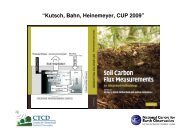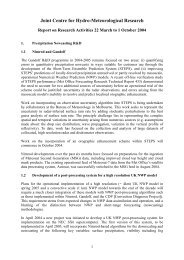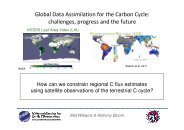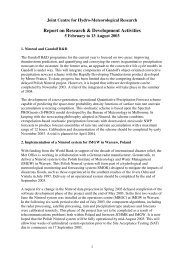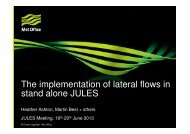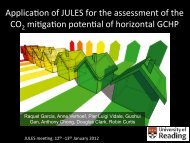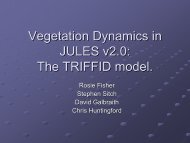Report - Joint Centre for Hydro-Meteorological Research
Report - Joint Centre for Hydro-Meteorological Research
Report - Joint Centre for Hydro-Meteorological Research
You also want an ePaper? Increase the reach of your titles
YUMPU automatically turns print PDFs into web optimized ePapers that Google loves.
11. Coupling CEH hydrological models to Met Office regional climate modelsAs part of a Defra-funded project, the Met Office’s Hadley <strong>Centre</strong> and CEH are developingmethods to predict flood frequencies over the UK in current and future climates. RegionalClimate Models (RCMs) are being coupled to CEH hydrological models to predict fluvialflooding, and coastal flooding when coupled to a shelf-sea model.An initial system to predict changes in fluvial flooding <strong>for</strong> the UK has already been developed(Bell et al., 2004a,b; Kay et al., 2005a,b). This system provides a grid-based methodology inthe <strong>for</strong>m of a grid-to-grid model <strong>for</strong> translating RCM meteorological variables, such as rainfalland evaporation, into estimates of river flow and fluvial outflow to the sea. The initialdevelopment work used a simple grid-based runoff-production scheme in order to progress thedevelopment of the routing component which trans<strong>for</strong>ms gridded runoff into river flow. Thisyear the routing scheme, called the Grid-to-Grid model or G2G, has been linked to the MetOffice land-surface scheme MOSES. The combined MOSES-G2G model now provides astand-alone plat<strong>for</strong>m to support research into broad-scale runoff-production and routingschemes.The combined model (Bell et al., 2005) is currently configured to the UK National Grid usedby the Met Office Nimrod nowcasting scheme with the Grid-to-Grid routing model operatingat a 1 km resolution. Initial results over the Thames Basin indicate that the new model isper<strong>for</strong>ming moderately well, with modelled and observed flow in the Thames showingreasonable agreement. The new modelling plat<strong>for</strong>m will support ‘offline’ investigation ofdifferent models of soil-moisture and runoff-production within MOSES, and will supportfurther development of the Grid-to-Grid routing model. Planned work in the coming year willapply the combined model to other areas of the UK at a 1km resolution, and to the EuropeanRCM domain at a 25km resolution.In order to apply the Grid-to-Grid flow routing model to the European RCM domain, initially aset of hand-corrected 25km resolution flow-directions were used that had been inferred from25km mean elevation data <strong>for</strong> Europe. Whilst the river networks and catchment areas derivedfrom these flow-directions were considered acceptable following hand-correction, some errorsremained. The hand-correction process proved time consuming, discouraging repeatedapplication to new regions. This would be a particular problem when the model is implementedwithin the regional climate modelling system, PRECIS, which is applied to many regionsacross the world. With the aim of overcoming the need <strong>for</strong> time-consuming hand-correction ofderived flow directions at a regional scale, three alternative methods <strong>for</strong> deriving rivernetworks from higher resolution DTM data have been explored. The current preferred methodof deriving flow directions at a coarse resolution involves first inferring flow directions usingan automated procedure applied to higher resolution DTM data. Only a limited amount ofhand-correction to overcome any residual errors is then required to obtain the final derivedflow directions.12. Climate change impact on dependence between river flow and sea surgeA small climate change impact study was undertaken as part of a larger study on jointprobability issues in flood and coastal defence, funded by Defra (FD2308, <strong>Joint</strong> probability:dependence mapping and best practice). The water level in a fluvial-tidal river reach is affectedby both river flow and sea level. If a predicted increase in these flood-producing variables is8



